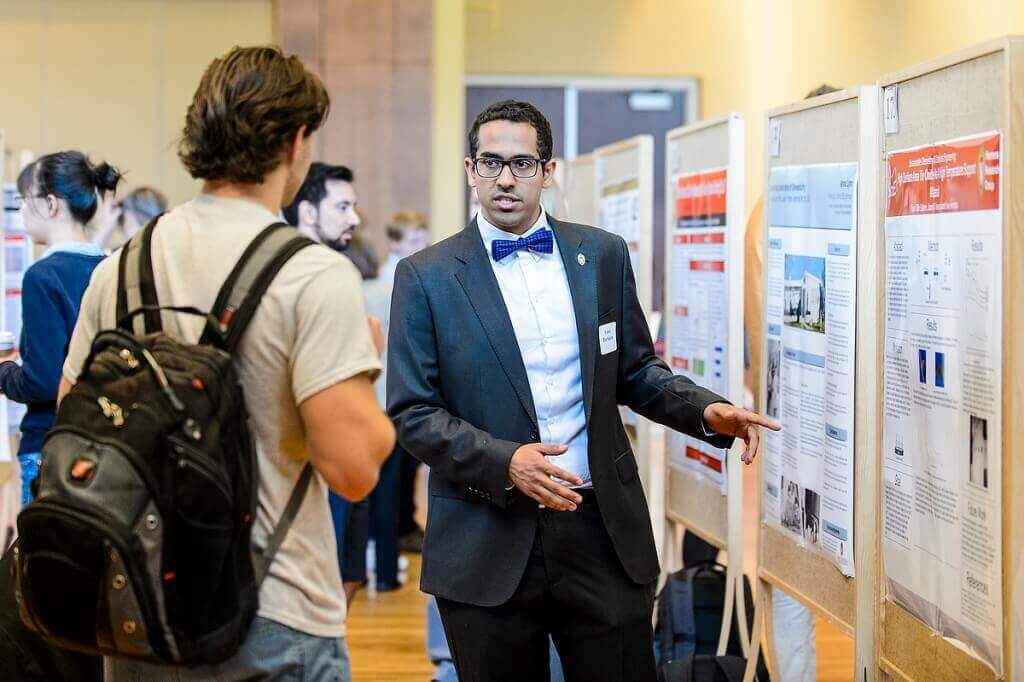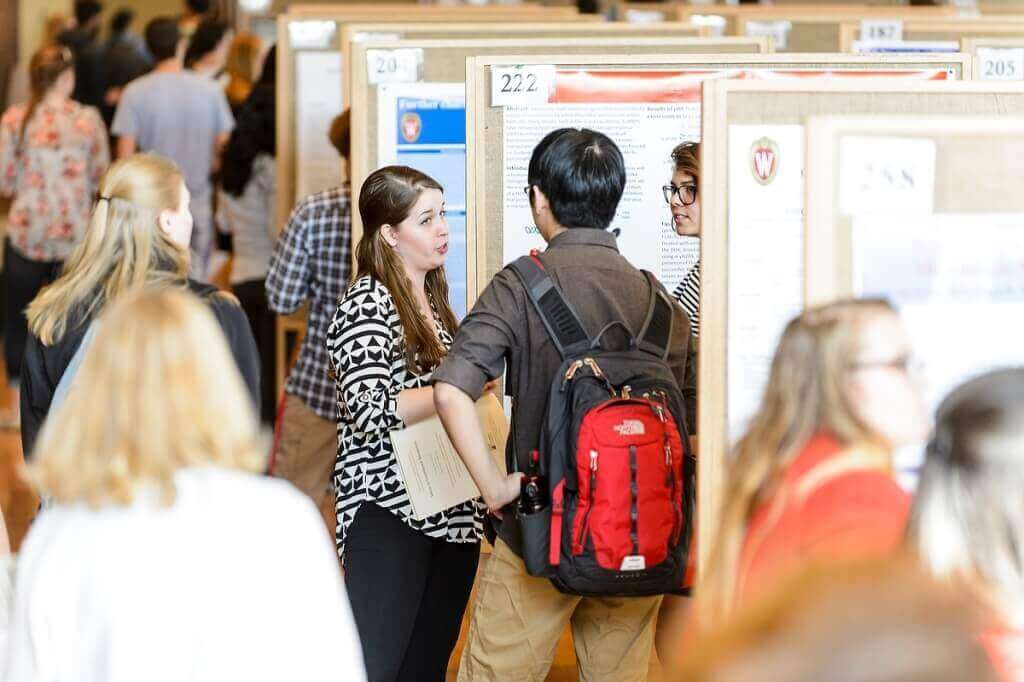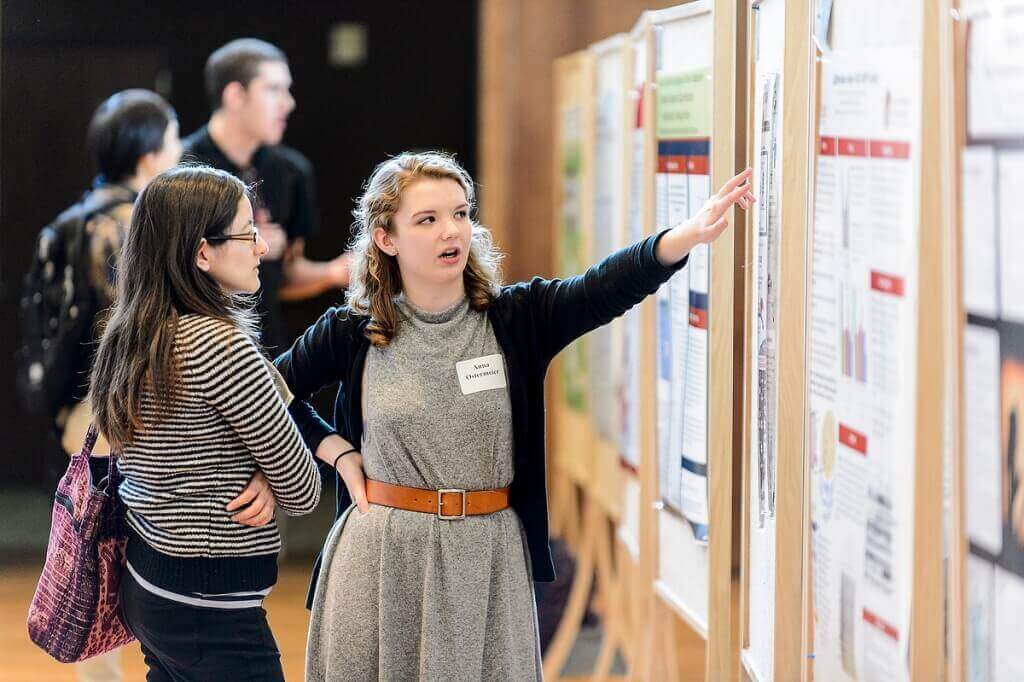Undergraduate Symposium gives student researchers the chance to shine

Faisal Bin Salem (right) presents his research project, “High Surface Area Tin Oxide as a High Temperature Support Material,” to attendees at the Undergraduate Symposium in Varsity Hall at Union South. Photo: Bryce Richter
More than 500 student presenters, all undergraduates at the University of Wisconsin–Madison, came together April 14 to showcase their creativity, achievement, research, service learning and community-based research.
The 2016 Undergraduate Symposium, held at Union South, offered hundreds of professional poster displays in Varsity Hall, as well as artists’ talks, performances and films.
Several students spoke with University Communications about what engaging in research means to them.
Emily Orals, senior
Majors: Biology and psychology
Project: Benefits of Maternal Contact and Breast Milk for Gut Microbiome Maturation of Infant Rhesus Monkeys
Mentor: Christopher Coe, professor of psychology and director of the Harlow Center for Biological Psychology
Q: How did you get involved with this topic?
A: I joined Dr. Coe’s lab my sophomore year. I was kind of thrust into the gut microbiome accidentally; I was more interested in observational studies and things like that, but I grew to love what the microbiome has to offer. My mom also pushed me in that direction by reading a lot of books about the Whole30 diet and how it influences your behavior and immunity.
As we know that the gut microbiome plays a major role in behavior and immunity, we wanted to know what role the mom’s presence plays in the gut bacterial microbiome of her infants. Eleven were nursery reared and seven were mother reared — essentially, breast milk vs. formula fed.
We found quite a bit of difference between the mother-reared and nursery-reared group. Mother-reared infants had significantly more bifidobacteria, which is a “good” probiotic. In nursery-reared infants, we saw that clostridium was pretty high — something we generally consider as bad.
Q: What has taking part in research meant to you?
A: I love working in my lab. I love everything about what my lab has brought to me in terms of exposure to research and meeting a research family. I feel when I’m going into the lab that I’m in a community where everyone’s pushing me to be a better student and a better person, looking for more in my research.
Research has made me not just a better student or applicant for medical school, or adding to my resume; it’s really shaped who I want to be in the future. I don’t think everyone can say that! It’s played such a big role in my life.

The symposium offered hundreds of professional poster displays as well as artists’ talks, performances and films. Photo: Bryce Richter
Mark Raphael Conti, sophomore
Major: Biology
Project: Building an Accessible Database of Patient Experience for the United States
Mentor: Nancy Pandhi, assistant professor of family medicine and community health
Q: How did you get involved with this topic?
A: We’re following a similar model to a site built in the UK called healthtalk.org. When I saw samples of the website in the UK, it had pictures, samples of the interviews and videos. It was a great idea; it helped give more info to patients, family members and even doctors of how to treat patients with certain diseases.
Q: Why did you gravitate toward social research, instead of more lab-based work?
A: I want to go to med school, and I enjoy the aspect of social interaction. With family medicine and community health, you gain a relationship with people. Reading these transcripts, I felt as though I knew these people. It’s a different type of research than a wet lab or molecular level, so it was a great opportunity for me to do a different type of research than what was probably in my head initially.

Anna Ostermeier (right), presenting “Unveiling the Journey of UW–Madison’s Waste,” was one of more than 500 student presenters who came together to showcase their creativity, achievement, research and service learning. Photo: Bryce Richter
Cal Thomas, sophomore
Major: Business
Amanda Himmerich, senior
Major: Computer science
(Also contributing: Kyle Casey)
Project: Innovation in Undergraduate Learning: Collective Intelligence in Quantitative Reasoning (CinqR)
Mentor: Amir Assadi, professor of mathematics and biomedical engineering
Q: How did you get involved with this topic?
Amanda: Professor Assadi suggested I do research after I took linear algebra. He asked me what my interests were and I said artificial intelligence and data analysis. He wanted people from diverse backgrounds to work together.
Q: You didn’t know each other?
Amanda: Nope. The experience has been good. Every other group project I’ve been in has been only people from my major, doing the same thing as me. You get more creative ideas when people come from different backgrounds.
Cal: I was in Math 141 [Quantitative Reasoning] last year. My project for the end of the semester involved doing homework together through social networking. Once [Assadi] saw that, he had this idea of collective intelligence, which wasn’t too far off from where I was. He brought me and Amanda together. She obviously knows much more about science and artificial intelligence; I knew how to bring it back to these Math 141 concepts.
Q: So what is your research about?
Amanda: It’s inspired by artificial intelligence: a simulation of neural networks in the brain. With committee networks, you train several neural networks and put a problem in and have them all involved in solving the problem after they’ve been trained individually. Those typically perform much better than if it’s just a single neural network. We’re sort of applying the same thing to human learning.
Cal: Collective intelligence is bringing a group together of people who have individual expertise; they work in a collaborative effort to teach each other. We based it on the Math 141 class. Each student learns a specific aspect of a whole objective concept. Then they come together; it increases in efficiency. Overall it allows them to get a better grasp of all the concepts from an objective basis because they work together. It’s great — you can use this with any type of learning.
Q: What has taking part in research meant to you?
Cal: It’s fun and puts you out of your comfort zone. Being a sophomore, you get used to homework, midterms, exams. Here, you have your idea and you can go many directions with it. Amir has stepped back and let us run with it.
Amanda: It’s satisfying. You’re working on something real. There’s something exciting about that to me. I’ve never worked in research before, so it’s adding a lot to my experience. Depending on what I want to do employment-wise, or grad school-wise, that’ll be helpful.
Tags: student life
